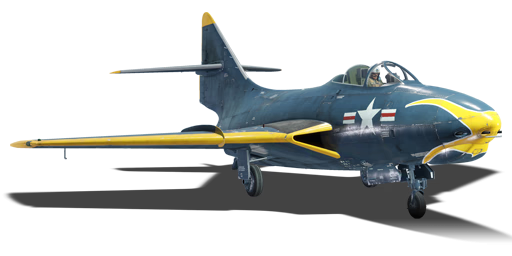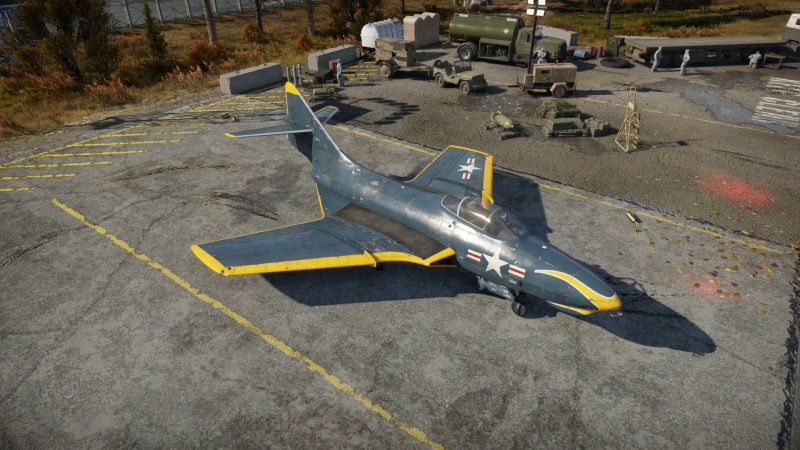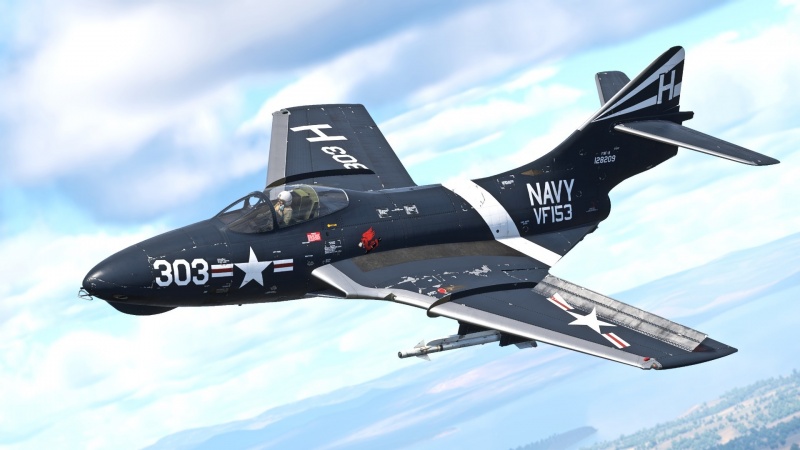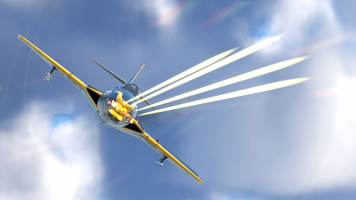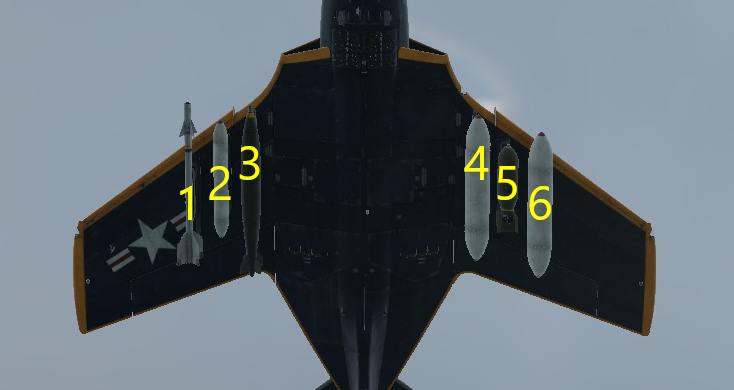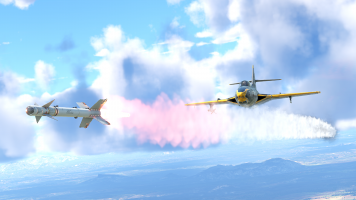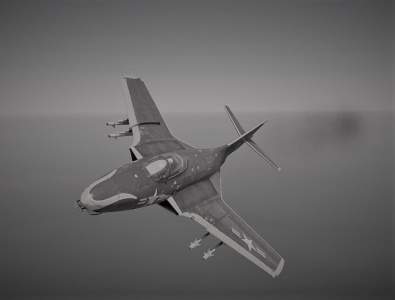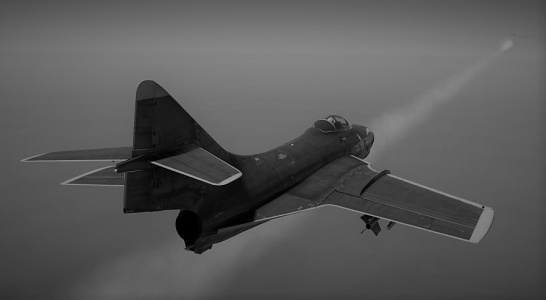Difference between revisions of "F9F-8"
(→Pros and cons) (Tag: Visual edit) |
(→Suspended armament: Updated) |
||
| (52 intermediate revisions by 20 users not shown) | |||
| Line 1: | Line 1: | ||
| + | {{About | ||
| + | | about = American naval jet fighter '''{{PAGENAME}}''' | ||
| + | | usage = other versions | ||
| + | | link = F9F (Family) | ||
| + | }} | ||
{{Specs-Card | {{Specs-Card | ||
|code=f9f-8 | |code=f9f-8 | ||
| − | |cockpit = | + | |images={{Specs-Card-Image|GarageImage_{{PAGENAME}}.jpg|ArtImage_{{PAGENAME}}.jpg}} |
| + | |cockpit=cockpit_f9f-8.jpg | ||
}} | }} | ||
| − | |||
== Description == | == Description == | ||
| − | <!--''In the description, the first part | + | <!-- ''In the description, the first part should be about the history of and the creation and combat usage of the aircraft, as well as its key features. In the second part, tell the reader about the aircraft in the game. Insert a screenshot of the vehicle, so that if the novice player does not remember the vehicle by name, he will immediately understand what kind of vehicle the article is talking about.'' --> |
| − | + | The '''{{Specs|name}}''' (Design 99) was Grumman's final fighter iteration of the Cougar. It was intended to have improved flight characteristics such as a lower stall speed and better control at high angles of attack. The wing had a thinner cross section which increased the top speed. In addition, the center fuselage was increased by 8 inches which helped with the stall speed. Around 600 F9F-8s were delivered to the U.S. Navy. F9F-8 crews found the plane to be quite good and reliable: however, new supersonic jets quickly made the Cougar obsolete and its service was cut short. Some F9Fs were to be utilized as trainer aircraft, but no Cougars would actively serve in the Vietnam War. | |
| − | + | ||
| − | The '''{{Specs|name}}''' | + | Introduced in [[Update 1.63 "Desert Hunters"]], the '''{{Specs|name}}''' is a good aircraft thanks to its improvements over the previous F9Fs and access to Sidewinders. The F9F-8 can carry bombs, rockets, and four AIM-9B missiles. Although AIM-9Bs are relatively weak, at the Cougar's BR they are quite handy in making opponents lose energy or quickly dispatching a slow target. Furthermore, the Cougar has four 20 mm cannons mounted in the chin of the aircraft which is incredibly lethal to fighters. Players should expect the F9F-8 to be a capable aircraft thanks to its weaponry and decent performance. |
== General info == | == General info == | ||
| − | === Flight | + | === Flight performance === |
| − | <!--''Describe how the aircraft behaves in the air. | + | {{Specs-Avia-Flight}} |
| − | {| class="wikitable" style="text-align:center" | + | <!-- ''Describe how the aircraft behaves in the air. Speed, manoeuvrability, acceleration and allowable loads - these are the most important characteristics of the vehicle.'' --> |
| − | + | ||
| − | + | The F9F Cougar is a further improvement of the F9F series with the main changes that are changed wings, now being swept and a new more powerful engine, the Pratt & Whitney J48-P-8A. It increased the level speed to 1041 km/h and when the plane carries four AIM-9B missiles it is 991 km/h at sea level, which is still slower than a MiG-15 or F-86. Its speed limit is also higher: 1127 km/h IAS. The level acceleration is almost the same compared to previous versions, but since it is faster it gets better above 850 km/h. | |
| − | + | The other aspect that has been slightly improved over the F9F-5 is climb rate, now can reach 29 m/s at sea level with full fuel tanks and increases to ~38 m/s with 20 minutes of fuel, it will not be able to out climb most of jet fighters from other nations at similar battle rating. | |
| − | ! | + | Flying at full power is limited to 30 minutes of operation until the engine overheats and can fly at 95% of power indefinitely. |
| − | + | ||
| − | ! colspan="2" | Max Speed<br>(km/h at | + | The Cougar wings' shape was changed a lot, the wing area was also increased. Due to lowered wing loading its low and medium speed turn rate was improved with the exception of stall speed which is higher, 217 km/h IAS with landing flaps. |
| − | ! rowspan="2" | Max altitude<br>( | + | The swept wings also increased the manoeuvrability at high speed, but the Cougar can lock up badly near transonic speeds, although it can use the airbrake to slow down to the speed where it retains the best turn rate, which is between 600 and 800 km/h IAS. The flaps cannot be used to improve dogfight capabilities, only one position for landing is available which use is limited to 410 km/h IAS. |
| + | Its roll rate up to 600 km/h IAS is almost the same, can reach up to ~100 degrees per second, but above its new wings allow the Cougar to improve it to ~150 degrees per second at 900 km/h. | ||
| + | One thing that did not change are very low G limits, they can be easily exceeded after reaching 9-10G above 600 km/h IAS. | ||
| + | |||
| + | With full real controls the plane can break its wings even easier than with enabled instructor, it is recommended to not install the New Boosters module. | ||
| + | Overall the plane has very good flight characteristics, especially at higher speed where it has good turning energy retention, even during pulling 5-6G. | ||
| + | |||
| + | {| class="wikitable" style="text-align:center" width="70%" | ||
| + | ! rowspan="2" | Characteristics | ||
| + | ! colspan="2" | Max Speed<br>(km/h at 610 m) | ||
| + | ! rowspan="2" | Max altitude<br>(metres) | ||
! colspan="2" | Turn time<br>(seconds) | ! colspan="2" | Turn time<br>(seconds) | ||
| − | ! colspan="2" | Rate of climb<br>( | + | ! colspan="2" | Rate of climb<br>(metres/second) |
| − | ! rowspan="2" |Take-off run<br>( | + | ! rowspan="2" | Take-off run<br>(metres) |
|- | |- | ||
| − | ! AB | + | ! AB !! RB !! AB !! RB !! AB !! RB |
| − | ! RB | ||
| − | ! AB | ||
| − | ! RB | ||
| − | ! AB | ||
| − | ! RB | ||
|- | |- | ||
| − | | | + | ! Stock |
| + | | 1,019 || 988 || rowspan="2" | {{Specs|ceiling}} || 33.7 || 34.3 || 22.1 || 20.6 || rowspan="2" | 500 | ||
|- | |- | ||
| − | ! | + | ! Upgraded |
| − | + | | 1,056 || 1,041 || 30.5 || 32.0 || 37.1 || 29.1 | |
| − | |||
| − | |||
| − | |||
| − | |||
| − | |||
| − | |||
| − | |||
| − | |||
| − | |||
| − | |||
| − | |||
| − | |||
| − | |||
| − | |||
|- | |- | ||
|} | |} | ||
| − | ====Details==== | + | ==== Details ==== |
| − | {| class="wikitable" style="text-align:center" | + | {| class="wikitable" style="text-align:center" width="50%" |
|- | |- | ||
| − | ! colspan=" | + | ! colspan="6" | Features |
|- | |- | ||
| − | ! Combat | + | ! Combat flaps !! Take-off flaps !! Landing flaps !! Air brakes !! Arrestor gear !! Drogue chute |
| − | ! Take-off | ||
| − | ! Landing | ||
| − | ! Air brakes | ||
| − | ! Arrestor gear | ||
|- | |- | ||
| − | | X || X || ✓ || ✓ || ✓ <!-- ✓ --> | + | | X || X || ✓ || ✓ || ✓ || X <!-- ✓ --> |
|- | |- | ||
|} | |} | ||
| − | {| class="wikitable" style="text-align:center" | + | {| class="wikitable" style="text-align:center" width="50%" |
|- | |- | ||
| − | ! colspan=" | + | ! colspan="7" | Limits |
|- | |- | ||
| − | ! rowspan="2" | | + | ! rowspan="2" | Wings (km/h) |
| − | ! rowspan="2" | Gear | + | ! rowspan="2" | Gear (km/h) |
| − | ! | + | ! colspan="3" | Flaps (km/h) |
! colspan="2" | Max Static G | ! colspan="2" | Max Static G | ||
|- | |- | ||
| − | ! + | + | ! Combat !! Take-off !! Landing !! + !! - |
| − | ! - | ||
|- | |- | ||
| − | | {{Specs| | + | | {{Specs|destruction|body}} || {{Specs|destruction|gear}} || N/A || N/A || 410 || ~9 || ~5 |
|- | |- | ||
|} | |} | ||
| Line 87: | Line 79: | ||
{| class="wikitable" style="text-align:center" | {| class="wikitable" style="text-align:center" | ||
|- | |- | ||
| − | ! colspan="4" | Optimal velocities | + | ! colspan="4" | Optimal velocities (km/h) |
|- | |- | ||
| − | ! Ailerons | + | ! Ailerons !! Rudder !! Elevators !! Radiator |
| − | ! Rudder | ||
| − | ! Elevators | ||
| − | ! Radiator | ||
|- | |- | ||
| − | | < 950 || < 790 || < 510 || | + | | < 950 || < 790 || < 510 || N/A |
|- | |- | ||
|} | |} | ||
| + | |||
| + | ==== Engine performance ==== | ||
{| class="wikitable" style="text-align:center" | {| class="wikitable" style="text-align:center" | ||
|- | |- | ||
| − | ! colspan="3" | | + | ! colspan="3" | Engine |
| + | ! colspan="6" | Aircraft mass | ||
|- | |- | ||
| − | ! colspan="3" | | + | ! colspan="2" | Engine name || Number |
| + | ! colspan="3" | {{Annotation|Basic mass|Mass of the aircraft with pilot and engine oil, but no fuel or weapons load}} || colspan="3" | Wing loading (full fuel) | ||
|- | |- | ||
| − | + | | colspan="2" | Pratt & Whitney J48-P-8A || 1 | |
| − | + | | colspan="3" | 6,001 kg || colspan="3" | 289 kg/m<sup>2</sup> | |
| − | |||
|- | |- | ||
| − | | | + | ! colspan="3" | Engine characteristics |
| + | ! colspan="5" | Mass with fuel (no weapons load) || rowspan="2" | Max Takeoff<br>Weight | ||
|- | |- | ||
| − | + | ! Weight (each) || colspan="2" | Type | |
| − | ! colspan=" | + | ! 17m fuel || 20m fuel || 30m fuel || 45m fuel || 58m fuel |
|- | |- | ||
| − | + | | 600 kg || colspan="2" | Centrifugal-flow turbojet | |
| − | + | | 6,906 kg || 7,027 kg || 7,541 kg || 8,311 kg || 9,019 kg || 9,636 kg | |
| − | |||
|- | |- | ||
| − | | | + | ! colspan="3" | {{Annotation|Maximum engine thrust @ 0 m (RB/SB)|The maximum thrust produced by each engine, while mounted in the aircraft. NOTE: Thrust varies significantly depending on speed & altitude.}} |
| + | ! colspan="6" | Thrust to weight ratio @ 0 m (100%) | ||
|- | |- | ||
| − | ! | + | ! Condition || 100% || WEP |
| + | ! 17m fuel || 20m fuel || 30m fuel || 45m fuel || 58m fuel || MTOW | ||
|- | |- | ||
| − | + | | ''Stationary'' || 3,182 kgf || N/A | |
| − | + | | 0.46 || 0.45 || 0.42 || 0.38 || 0.35 || 0.33 | |
| − | |||
|- | |- | ||
| − | | | + | | ''Optimal'' || 3,182 kgf<br>(0 km/h) || N/A |
| + | | 0.46 || 0.45 || 0.42 || 0.38 || 0.35 || 0.33 | ||
|- | |- | ||
| − | |||
|} | |} | ||
=== Survivability and armour === | === Survivability and armour === | ||
| − | ''Examine the survivability of the aircraft. Note how vulnerable the structure is and how secure the pilot is, whether the fuel tanks are armoured. Describe the armour, if there is any, also mention the vulnerability of other critical aircraft systems.'' | + | {{Specs-Avia-Armour}} |
| + | <!-- ''Examine the survivability of the aircraft. Note how vulnerable the structure is and how secure the pilot is, whether the fuel tanks are armoured, etc. Describe the armour, if there is any, and also mention the vulnerability of other critical aircraft systems.'' --> | ||
| + | * 9.5 mm steel - in front of cockpit | ||
| + | * 8.5 mm steel - behind pilot | ||
| + | * 60 mm steel - armoured windscreen | ||
| + | |||
| + | === Modifications and economy === | ||
| + | {{Specs-Economy}} | ||
| + | |||
| + | [[File:ArtImage3 F9F-8.png|thumb|right|x200px|F9F-8 fires its 4 x 20 mm M3 cannons]] | ||
== Armaments == | == Armaments == | ||
| + | {{Specs-Avia-Armaments}} | ||
=== Offensive armament === | === Offensive armament === | ||
| + | {{Specs-Avia-Offensive}} | ||
| + | <!-- ''Describe the offensive armament of the aircraft, if any. Describe how effective the cannons and machine guns are in a battle, and also what belts or drums are better to use. If there is no offensive weaponry, delete this subsection.'' --> | ||
| + | {{main|M3 (20 mm)}} | ||
| − | + | The '''''{{PAGENAME}}''''' is armed with: | |
| − | + | ||
| − | + | * 4 x 20 mm M3 cannons, nose-mounted (190 rpg = 760 total) | |
=== Suspended armament === | === Suspended armament === | ||
| − | ''Describe the aircraft's suspended armament: additional cannons under the wings, bombs, rockets and torpedoes. This section is especially important for bombers and attackers. If there is no suspended weaponry remove this subsection.'' | + | {{Specs-Avia-Suspended}} |
| + | <!-- ''Describe the aircraft's suspended armament: additional cannons under the wings, bombs, rockets and torpedoes. This section is especially important for bombers and attackers. If there is no suspended weaponry remove this subsection.'' --> | ||
| − | + | The '''''{{PAGENAME}}''''' can be outfitted with the following ordnance: | |
| − | '' | ||
| − | + | {| class="wikitable" style="text-align:center" width="100%" | |
| − | {| class="wikitable" style="text-align:center" | + | |- |
| + | ! !! width="7%" | 1 !! width="7%" | 2 !! width="7%" | 3 !! width="7%" | 4 !! width="7%" | 5 !! width="7%" | 6 | ||
| + | | rowspan="6" width="30%" | <div class="ttx-image">[[File:Hardpoints_{{PAGENAME}}.png]]</div> | ||
| + | |- | ||
| + | ! [[AN-M64A1 (500 lb)|500 lb AN-M64A1]] bombs | ||
| + | | 1 || 1 || 1 || 1 || 1 || 1 | ||
|- | |- | ||
| − | ! | + | ! [[LDGP Mk 83 (1,000 lb)|1,000 lb LDGP Mk 83]] bombs |
| + | | || || 1 || 1 || || | ||
|- | |- | ||
| − | ! | + | ! [[FFAR Mighty Mouse]] rockets |
| − | + | | 7, 19 || 7, 19 || 7, 19 || 7, 19 || 7, 19 || 7, 19 | |
| − | |||
| − | |||
| − | |||
|- | |- | ||
| − | ! | + | ! [[AIM-9B Sidewinder]] missiles |
| − | + | | 1 || 1 || || || 1 || 1 | |
| − | |||
|- | |- | ||
| − | | | + | | colspan="7" | Maximum permissible loadout weight: 1,820 kg<br>Maximum permissible wing load: 910 kg<br>Maximum permissible weight imbalance: 650 kg |
|- | |- | ||
|} | |} | ||
| − | == | + | {{Navigation-Start|Default weapon presets}} |
| − | + | {{Navigation-First-Simple-Line}} | |
| − | + | * Without load | |
| − | + | * 2 x AIM-9B Sidewinder missiles | |
| − | + | * 4 x AIM-9B Sidewinder missiles | |
| − | + | * 42 x FFAR Mighty Mouse rockets | |
| − | + | * 114 x FFAR Mighty Mouse rockets | |
| − | + | * 6 x 500 lb AN-M64A1 bombs (3,000 lb total) | |
| − | + | * 2 x 1,000 lb LDGP Mk 83 bombs (2,000 lb total) | |
| − | + | {{Navigation-End}} | |
| − | + | ||
| − | + | == Usage in battles == | |
| − | |- | + | <!-- ''Describe the tactics of playing in the aircraft, the features of using aircraft in a team and advice on tactics. Refrain from creating a "guide" - do not impose a single point of view, but instead, give the reader food for thought. Examine the most dangerous enemies and give recommendations on fighting them. If necessary, note the specifics of the game in different modes (AB, RB, SB).'' --> |
| − | + | [[File:ArtImage2 F9F-8.png|thumb|right|x200px|F9F-8 launches an AIM-9B Sidewinder]] | |
| − | + | ||
| − | + | First of your objective when you purchase this plane is to research as fast as you can the 20 mm cannons modifications. The F9F-8 default cannons get jammed in a quick burst. | |
| − | | | + | |
| − | | | + | This said don't expect to dogfight very well against any pure fighter jet as the turn time is quite stock but when you spade it outturning does get a better but the F9F-8 performs great defensive manoeuvres and can keep up in turns with the MiGs (beware that doesn't have the great acceleration that MiGs have). |
| + | |||
| + | This is not an air superiority aircraft, its main purpose is to support ground vehicles and planes. | ||
| + | |||
| + | The best tactics if you are new to this plane is to fly it like a F9F-2 or F9F-5 so stay near some allies and give them support. | ||
| + | |||
| + | * Never roll too hard over 750 km/h (466 mph) or the wings will explode | ||
| + | * Never execute manoeuvres over –2 G or the wings will explode | ||
| + | |||
| + | === Radars === | ||
| + | <!--{{main|AN/APG-30}}--> | ||
| + | The F9F-8 is equipped with an AN/APG-30 rangefinding radar, located in the nose of the aircraft. | ||
| + | It will automatically detect other planes within the scanning area and display the range to the closest target. It is linked with a gyro gunsight and can help with aiming at close range. | ||
| + | |||
| + | {| class="wikitable" style="text-align:center" | ||
| + | ! colspan="4" | AN/APG-30 - Rangefinding radar | ||
|- | |- | ||
| − | | | + | ! {{Annotation|Maximum<br/>Tracking<br/>Range|The maximum range at which a target can be tracked}} |
| − | | | + | ! {{Annotation|Minimum<br/>Tracking<br/>Range|The range below which targets cannot be tracked by the radar}} |
| − | | | + | ! {{Annotation|Azimuth Tracking<br/>Angle|How far to each side the radar can track a target}} |
| − | | | + | ! {{Annotation|Elevation Tracking<br/>Angle|How far up and down the radar can track a target}} |
| − | | | ||
|- | |- | ||
| − | | | + | | 2,750 m || 300 m || ±9° || ±9° |
| − | | | ||
| − | | | ||
| − | | | ||
| − | | | ||
|- | |- | ||
|} | |} | ||
=== Pros and cons === | === Pros and cons === | ||
| − | <!--'' | + | <!-- ''Summarise and briefly evaluate the vehicle in terms of its characteristics and combat effectiveness. Mark its pros and cons in the bulleted list. Try not to use more than 6 points for each of the characteristics. Avoid using categorical definitions such as "bad", "good" and the like - use substitutions with softer forms such as "inadequate" and "effective".'' --> |
| + | |||
'''Pros:''' | '''Pros:''' | ||
| − | * | + | * Adequate bomb payloads for ground attack |
| − | * | + | * Hard-hitting 20mm cannons which can shred aircraft and light ground vehicles and have a lot of ammo |
| − | * | + | * Above average top speed |
| − | * Can equip | + | * Can equip up to four AIM-9B Sidewinder heat seeking air-to-air missiles (additionally, the F9F-8 is the second lowest BR vehicle to have them) |
| + | * Great roll rate | ||
| + | * Acceptable turn radius | ||
'''Cons:''' | '''Cons:''' | ||
| − | * | + | * Significant control surface compression at high speeds |
| − | * | + | * Cannot outrun most jets faced in an uptier |
| − | * | + | * Bad energy retention |
| + | * Guns jam quickly without the "New 20mm cannons" modification | ||
== History == | == History == | ||
| − | ''Describe the history of the creation and combat usage of the aircraft in more detail than in the introduction. If the historical reference turns out to be too | + | <!-- ''Describe the history of the creation and combat usage of the aircraft in more detail than in the introduction. If the historical reference turns out to be too long, take it to a separate article, taking a link to the article about the vehicle and adding a block "/History" (example: <nowiki>https://wiki.warthunder.com/(Vehicle-name)/History</nowiki>) and add a link to it here using the <code>main</code> template. Be sure to reference text and sources by using <code><nowiki><ref></ref></nowiki></code>, as well as adding them at the end of the article with <code><nowiki><references /></nowiki></code>. This section may also include the vehicle's dev blog entry (if applicable) and the in-game encyclopedia description (under <code><nowiki>=== In-game description ===</nowiki></code>, also if applicable).'' --> |
| + | |||
| + | It was Grumman's engineers who first thought of developing their successful F9F Panther fighter into a swept-wing variant. The resulting ''Cougar'' was a very new design in many ways bucking post-war design trends. The fuselage, fin and rudder remained the same, however, the wings were completely new with a 35-degree sweep and lacking the distinctive wingtip tanks of the Panther. The engine was also an upgrade, a Pratt and Whitney J48 with an extra 1,000 kg of thrust over the previous J42. First flight was 20 September 1951, with operational trials starting three months later. Squadron deliveries began in November 1952. 706 F9F-6s with the original engine were produced, and 168 of the F9F-7 which used the Allison J33 turbojet instead. | ||
| + | |||
| + | The F9F-8 was the final version. Its prototype's first flight was December 1953. In this model, the fuselage was lengthened 30 cm to increase the space for fuel tanks. It had the J48-P-8 engines installed that gave it a total of 3,447kg of Thrust, the wings were also modified slightly to add an in-air refuelling probe plus the capability of mounting four Aim-9 sidewinders and a nose radar was fitted. In total, 601 F9F-8s were built. | ||
| + | |||
| + | The F9F-8 was too late to see combat in Korea, however, there were four trainer versions of the F9F-8 (F9F-8T) deployed to Vietnam and was used in airstrike directing for incoming allied aircraft. | ||
| + | |||
| + | The Argentine Navy was the only other nation to operate the F9F-8 and was the first jet aircraft that they ever had capable of breaking the sound barrier (In a dive). | ||
| + | |||
| + | It is also worth noting that the F9F-8 was redesignated, as part of the United States Tri-Service Designation System, to the F-9J in 1962. | ||
== Media == | == Media == | ||
| − | '' | + | <!-- ''Excellent additions to the article would be video guides, screenshots from the game, and photos.'' --> |
| + | |||
| + | ;Skins | ||
| + | |||
| + | * [https://live.warthunder.com/feed/camouflages/?vehicle=f9f-8 Skins and camouflages for the {{PAGENAME}} from live.warthunder.com.] | ||
| + | {{Skin-gallery|market|ugcitem_1000237|F9F-8 Lynx.png|Camo "Lynx"}} | ||
| + | |||
| + | ;Images | ||
| + | <gallery mode="packed-hover" heights="200"> | ||
| + | File:F9F-8 left-hand banking turn (In-Game).jpg|<small>Left-hand banking turn</small> | ||
| + | File:F9F-8 Sidewinder.jpg|<small>Sidewinder</small> | ||
| + | </gallery> | ||
| + | |||
| + | ;Videos | ||
| + | {{Youtube-gallery|pEC-vTUmio4|'''This Plane Used To Be Terrible''' - ''Spit_flyer''|WdnBY3NcWiE|'''Why you should grind to F9F Cougar (Jet Gameplay)''' - ''PhlyDaily''|iQ97c_m8G0I|'''The Shooting Range #16''' - ''Pages of History'' section at 04:05 discusses the F9F-8.}} | ||
== See also == | == See also == | ||
| − | ''Links to the articles on the War Thunder Wiki that you think will be useful for the reader, for example:'' | + | <!-- ''Links to the articles on the War Thunder Wiki that you think will be useful for the reader, for example:'' |
| + | * ''reference to the series of the aircraft;'' | ||
| + | * ''links to approximate analogues of other nations and research trees.'' --> | ||
| − | * | + | ;[[F9F (Family)|Related development]] |
| − | * | + | |
| + | * [[F9F-2]] | ||
| + | * [[F9F-5]] | ||
== External links == | == External links == | ||
| − | <!--''Paste links to sources and external resources, such as:'' | + | <!-- ''Paste links to sources and external resources, such as:'' |
* ''topic on the official game forum;'' | * ''topic on the official game forum;'' | ||
| − | + | * ''other literature.'' --> | |
| − | * ''other literature.''--> | ||
| − | * [ | + | * [[wt:en/news/4239-development-f9f-8-cougar-a-perfect-predator-en/|[Devblog] F9F-8 Cougar - A Perfect Predator]] |
| + | * [https://forum.warthunder.com/index.php?/topic/330721-f9f-8/ Official data sheet - more details about the performance] | ||
| + | {{AirManufacturer Grumman}} | ||
{{USA jet aircraft}} | {{USA jet aircraft}} | ||
Latest revision as of 19:45, 19 June 2024
| This page is about the American naval jet fighter F9F-8. For other versions, see F9F (Family). |
Contents
Description
The F9F-8 Cougar (Design 99) was Grumman's final fighter iteration of the Cougar. It was intended to have improved flight characteristics such as a lower stall speed and better control at high angles of attack. The wing had a thinner cross section which increased the top speed. In addition, the center fuselage was increased by 8 inches which helped with the stall speed. Around 600 F9F-8s were delivered to the U.S. Navy. F9F-8 crews found the plane to be quite good and reliable: however, new supersonic jets quickly made the Cougar obsolete and its service was cut short. Some F9Fs were to be utilized as trainer aircraft, but no Cougars would actively serve in the Vietnam War.
Introduced in Update 1.63 "Desert Hunters", the F9F-8 Cougar is a good aircraft thanks to its improvements over the previous F9Fs and access to Sidewinders. The F9F-8 can carry bombs, rockets, and four AIM-9B missiles. Although AIM-9Bs are relatively weak, at the Cougar's BR they are quite handy in making opponents lose energy or quickly dispatching a slow target. Furthermore, the Cougar has four 20 mm cannons mounted in the chin of the aircraft which is incredibly lethal to fighters. Players should expect the F9F-8 to be a capable aircraft thanks to its weaponry and decent performance.
General info
Flight performance
The F9F Cougar is a further improvement of the F9F series with the main changes that are changed wings, now being swept and a new more powerful engine, the Pratt & Whitney J48-P-8A. It increased the level speed to 1041 km/h and when the plane carries four AIM-9B missiles it is 991 km/h at sea level, which is still slower than a MiG-15 or F-86. Its speed limit is also higher: 1127 km/h IAS. The level acceleration is almost the same compared to previous versions, but since it is faster it gets better above 850 km/h. The other aspect that has been slightly improved over the F9F-5 is climb rate, now can reach 29 m/s at sea level with full fuel tanks and increases to ~38 m/s with 20 minutes of fuel, it will not be able to out climb most of jet fighters from other nations at similar battle rating. Flying at full power is limited to 30 minutes of operation until the engine overheats and can fly at 95% of power indefinitely.
The Cougar wings' shape was changed a lot, the wing area was also increased. Due to lowered wing loading its low and medium speed turn rate was improved with the exception of stall speed which is higher, 217 km/h IAS with landing flaps. The swept wings also increased the manoeuvrability at high speed, but the Cougar can lock up badly near transonic speeds, although it can use the airbrake to slow down to the speed where it retains the best turn rate, which is between 600 and 800 km/h IAS. The flaps cannot be used to improve dogfight capabilities, only one position for landing is available which use is limited to 410 km/h IAS. Its roll rate up to 600 km/h IAS is almost the same, can reach up to ~100 degrees per second, but above its new wings allow the Cougar to improve it to ~150 degrees per second at 900 km/h. One thing that did not change are very low G limits, they can be easily exceeded after reaching 9-10G above 600 km/h IAS.
With full real controls the plane can break its wings even easier than with enabled instructor, it is recommended to not install the New Boosters module. Overall the plane has very good flight characteristics, especially at higher speed where it has good turning energy retention, even during pulling 5-6G.
| Characteristics | Max Speed (km/h at 610 m) |
Max altitude (metres) |
Turn time (seconds) |
Rate of climb (metres/second) |
Take-off run (metres) | |||
|---|---|---|---|---|---|---|---|---|
| AB | RB | AB | RB | AB | RB | |||
| Stock | 1,019 | 988 | 12500 | 33.7 | 34.3 | 22.1 | 20.6 | 500 |
| Upgraded | 1,056 | 1,041 | 30.5 | 32.0 | 37.1 | 29.1 | ||
Details
| Features | |||||
|---|---|---|---|---|---|
| Combat flaps | Take-off flaps | Landing flaps | Air brakes | Arrestor gear | Drogue chute |
| X | X | ✓ | ✓ | ✓ | X |
| Limits | ||||||
|---|---|---|---|---|---|---|
| Wings (km/h) | Gear (km/h) | Flaps (km/h) | Max Static G | |||
| Combat | Take-off | Landing | + | - | ||
| 1127 | 410 | N/A | N/A | 410 | ~9 | ~5 |
| Optimal velocities (km/h) | |||
|---|---|---|---|
| Ailerons | Rudder | Elevators | Radiator |
| < 950 | < 790 | < 510 | N/A |
Engine performance
| Engine | Aircraft mass | |||||||
|---|---|---|---|---|---|---|---|---|
| Engine name | Number | Basic mass | Wing loading (full fuel) | |||||
| Pratt & Whitney J48-P-8A | 1 | 6,001 kg | 289 kg/m2 | |||||
| Engine characteristics | Mass with fuel (no weapons load) | Max Takeoff Weight | ||||||
| Weight (each) | Type | 17m fuel | 20m fuel | 30m fuel | 45m fuel | 58m fuel | ||
| 600 kg | Centrifugal-flow turbojet | 6,906 kg | 7,027 kg | 7,541 kg | 8,311 kg | 9,019 kg | 9,636 kg | |
| Maximum engine thrust @ 0 m (RB/SB) | Thrust to weight ratio @ 0 m (100%) | |||||||
| Condition | 100% | WEP | 17m fuel | 20m fuel | 30m fuel | 45m fuel | 58m fuel | MTOW |
| Stationary | 3,182 kgf | N/A | 0.46 | 0.45 | 0.42 | 0.38 | 0.35 | 0.33 |
| Optimal | 3,182 kgf (0 km/h) |
N/A | 0.46 | 0.45 | 0.42 | 0.38 | 0.35 | 0.33 |
Survivability and armour
- 9.5 mm steel - in front of cockpit
- 8.5 mm steel - behind pilot
- 60 mm steel - armoured windscreen
Modifications and economy
Armaments
Offensive armament
The F9F-8 is armed with:
- 4 x 20 mm M3 cannons, nose-mounted (190 rpg = 760 total)
Suspended armament
The F9F-8 can be outfitted with the following ordnance:
| 1 | 2 | 3 | 4 | 5 | 6 | ||
|---|---|---|---|---|---|---|---|
| 500 lb AN-M64A1 bombs | 1 | 1 | 1 | 1 | 1 | 1 | |
| 1,000 lb LDGP Mk 83 bombs | 1 | 1 | |||||
| FFAR Mighty Mouse rockets | 7, 19 | 7, 19 | 7, 19 | 7, 19 | 7, 19 | 7, 19 | |
| AIM-9B Sidewinder missiles | 1 | 1 | 1 | 1 | |||
| Maximum permissible loadout weight: 1,820 kg Maximum permissible wing load: 910 kg Maximum permissible weight imbalance: 650 kg | |||||||
| Default weapon presets | |
|---|---|
| |
Usage in battles
First of your objective when you purchase this plane is to research as fast as you can the 20 mm cannons modifications. The F9F-8 default cannons get jammed in a quick burst.
This said don't expect to dogfight very well against any pure fighter jet as the turn time is quite stock but when you spade it outturning does get a better but the F9F-8 performs great defensive manoeuvres and can keep up in turns with the MiGs (beware that doesn't have the great acceleration that MiGs have).
This is not an air superiority aircraft, its main purpose is to support ground vehicles and planes.
The best tactics if you are new to this plane is to fly it like a F9F-2 or F9F-5 so stay near some allies and give them support.
- Never roll too hard over 750 km/h (466 mph) or the wings will explode
- Never execute manoeuvres over –2 G or the wings will explode
Radars
The F9F-8 is equipped with an AN/APG-30 rangefinding radar, located in the nose of the aircraft. It will automatically detect other planes within the scanning area and display the range to the closest target. It is linked with a gyro gunsight and can help with aiming at close range.
| AN/APG-30 - Rangefinding radar | |||
|---|---|---|---|
| Maximum Tracking Range |
Minimum Tracking Range |
Azimuth Tracking Angle |
Elevation Tracking Angle |
| 2,750 m | 300 m | ±9° | ±9° |
Pros and cons
Pros:
- Adequate bomb payloads for ground attack
- Hard-hitting 20mm cannons which can shred aircraft and light ground vehicles and have a lot of ammo
- Above average top speed
- Can equip up to four AIM-9B Sidewinder heat seeking air-to-air missiles (additionally, the F9F-8 is the second lowest BR vehicle to have them)
- Great roll rate
- Acceptable turn radius
Cons:
- Significant control surface compression at high speeds
- Cannot outrun most jets faced in an uptier
- Bad energy retention
- Guns jam quickly without the "New 20mm cannons" modification
History
It was Grumman's engineers who first thought of developing their successful F9F Panther fighter into a swept-wing variant. The resulting Cougar was a very new design in many ways bucking post-war design trends. The fuselage, fin and rudder remained the same, however, the wings were completely new with a 35-degree sweep and lacking the distinctive wingtip tanks of the Panther. The engine was also an upgrade, a Pratt and Whitney J48 with an extra 1,000 kg of thrust over the previous J42. First flight was 20 September 1951, with operational trials starting three months later. Squadron deliveries began in November 1952. 706 F9F-6s with the original engine were produced, and 168 of the F9F-7 which used the Allison J33 turbojet instead.
The F9F-8 was the final version. Its prototype's first flight was December 1953. In this model, the fuselage was lengthened 30 cm to increase the space for fuel tanks. It had the J48-P-8 engines installed that gave it a total of 3,447kg of Thrust, the wings were also modified slightly to add an in-air refuelling probe plus the capability of mounting four Aim-9 sidewinders and a nose radar was fitted. In total, 601 F9F-8s were built.
The F9F-8 was too late to see combat in Korea, however, there were four trainer versions of the F9F-8 (F9F-8T) deployed to Vietnam and was used in airstrike directing for incoming allied aircraft.
The Argentine Navy was the only other nation to operate the F9F-8 and was the first jet aircraft that they ever had capable of breaking the sound barrier (In a dive).
It is also worth noting that the F9F-8 was redesignated, as part of the United States Tri-Service Designation System, to the F-9J in 1962.
Media
- Skins
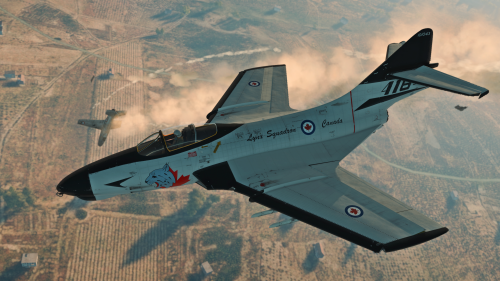
- Images
- Videos
See also
External links
- [Devblog] F9F-8 Cougar - A Perfect Predator
- Official data sheet - more details about the performance
| Grumman Aircraft Engineering Corporation | |
|---|---|
| Aircraft | |
| Fighters | |
| F3F | F3F-2 · Galer's F3F-2 |
| F4F Wildcat | F4F-3 · F4F-4 |
| XF5F Skyrocket | XF5F · XP-50 |
| F6F Hellcat | F6F-5 · F6F-5N |
| F7F Tigercat | F7F-1 · F7F-3 |
| F8F Bearcat | F8F-1 · F8F-1B |
| Jet Fighters | |
| F9F Panther/Cougar | F9F-2 · F9F-5 · F9F-8 |
| F-11 Tiger | F11F-1 |
| F-14 Tomcat | F-14A Early · F-14B |
| Jet Strike Aircraft | |
| A-6 Intruder | A-6E TRAM |
| Bombers | TBF-1C |
| Export | ▄Martlet Mk IV · ▄F6F-5 · ▄F6F-5N · ▄F8F-1B · ▄Avenger Mk II · ▄Hellcat Mk II |
| ▄F-14A IRIAF | |
| Naval Vehicles | |
| Patrol Gunboat Hydrofoil (PGH) | USS Flagstaff |
| USA jet aircraft | |
|---|---|
| Fighters | |
| F9F | F9F-2 · F9F-5 · F9F-8 |
| F-80 | F-80A-5 · F-80C-10 |
| F-84 | F-84B-26 · F-84F · F-84G-21-RE |
| F-86 | F-86A-5 · F-86F-25 · F-86F-2 · F-86F-35 |
| F-89 | F-89B · F-89D |
| F-100 | F-100D |
| F-104 | F-104A · F-104C |
| F-4 | F-4C Phantom II · F-4E Phantom II · F-4J Phantom II · F-4S Phantom II |
| F-5 | F-5A · F-5C · F-5E · F-20A |
| F-8 | F8U-2 · F-8E |
| F-14 | F-14A Early · ▄F-14A IRIAF · F-14B |
| F-15 | F-15A · F-15C MSIP II · F-15E |
| F-16 | F-16A · F-16A ADF · F-16C |
| Other | P-59A · F2H-2 · F3D-1 · F3H-2 · F4D-1 · F11F-1 |
| Strike Aircraft | |
| FJ-4 | FJ-4B · FJ-4B VMF-232 |
| A-4 | A-4B · A-4E Early |
| A-7 | A-7D · A-7E · A-7K |
| AV-8 | AV-8A · AV-8C · AV-8B Plus · AV-8B (NA) |
| A-10 | A-10A · A-10A Late · A-10C |
| F-111 | F-111A · F-111F |
| Other | A-6E TRAM · F-105D · F-117 |
| Bombers | |
| B-57 | B-57A · B-57B |


